Skiing in Chamonix
Chamonix’s piste skiing is divided between four domains (Brevent-Flegere, Grands-Montets, Balme-Le Tour-Vallorcine and Les Houches) and six low altitude specialist beginners’ areas. For off-piste skiers, the Aiguille du Midi cable car, the Mer de Glace gondola and the Montenvers cog railway combine to give skiers access to and from the Vallee Blanche.
Chamonix Ski Area Overview
Brevent-Flegere, including Le Savoy and Plateau 2000 Beginners’ Areas
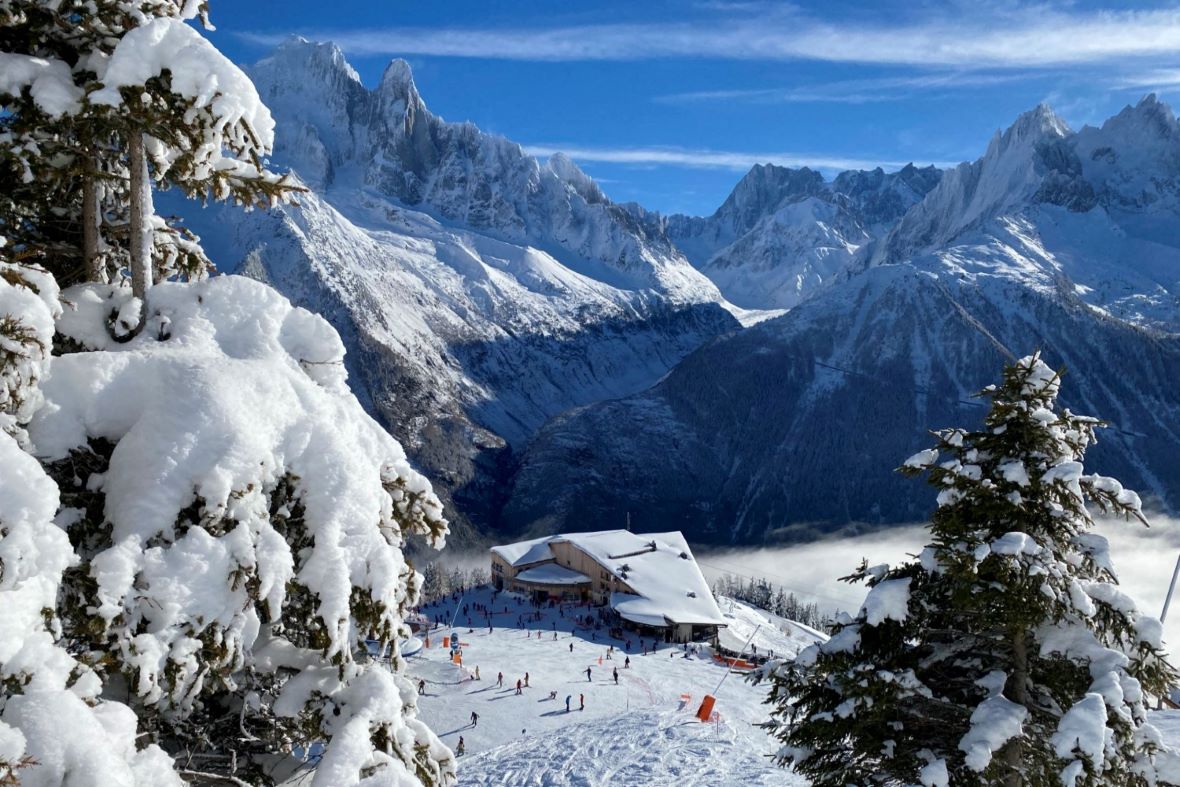
Brevent-Flegere (c) Benjamin_FRISON_Compagnie_du_Mont-Blanc
Brevent and Flegere are linked at mid-mountain by a cable car, forming the Brevent-Flegere Domaine which has about 25 separate pistes, and a top lift reaching 2,525m. Brevent is on the north side of Chamonix, accessed by the Planpraz lift on the northern edge of the town. At the top of the lift is the Plateau 2000 beginners’ area and at its foot is Le Savoy, a low altitude beginners’ area which extends into the heart of the town. Flegere is accessed from Les Praz, a village on the eastern outskirts of Chamonix. Brevent-Flegere has runs for all standards, including gentle blues and genuinely challenging black runs, plus extensive between-the-pistes freeriding terrain, and excellent red runs. The ski area faces south so gets a lot of sunshine.
Les Grands Montets, including Les Chosalets and Plateau de Lognan Beginners Areas
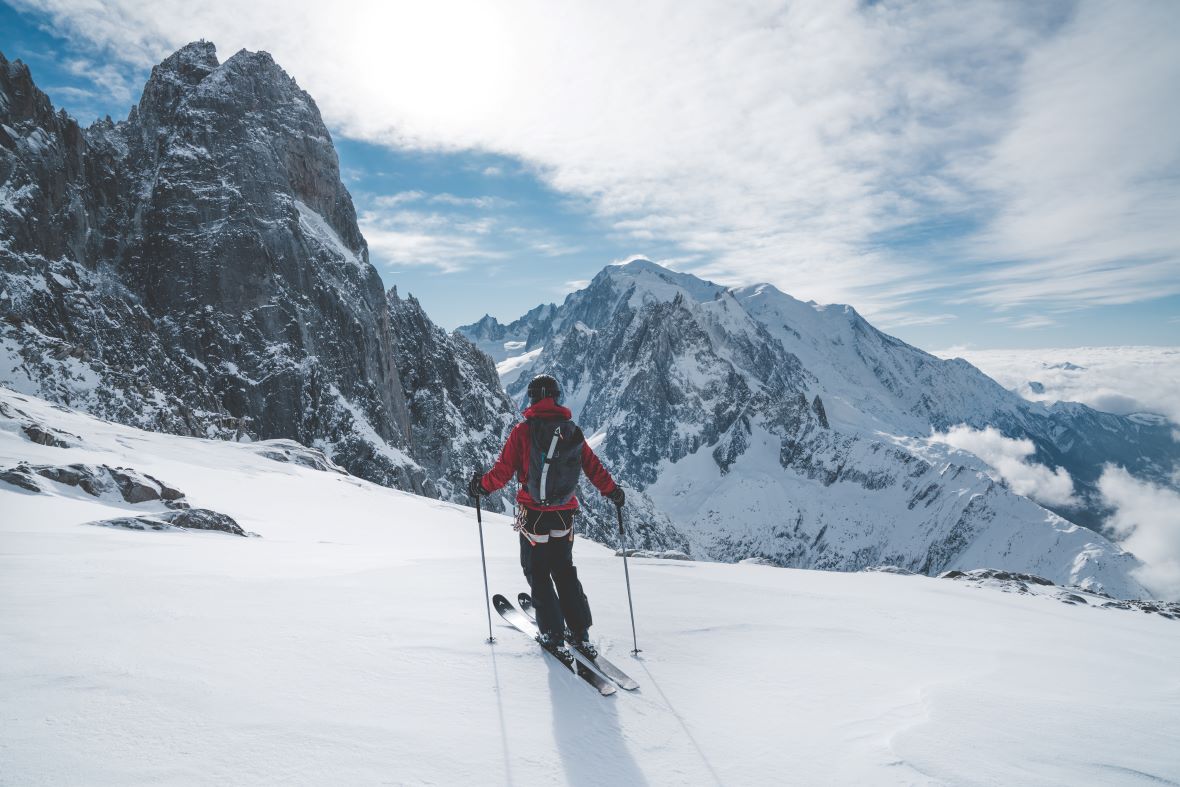
Les-Grands-Montets (c)Yucca_Films-1942
Les Grands Montets above the village of Argentiere has about a dozen pistes and a top cable car, currently out of action, that reaches 3,275m (whilst this is closed, the highest lift is the Bochard gondola which reaches 2,765m). Most of the slopes face north or northwest, helping to preserve the snow. The piste network is dominated by steep red slopes and ungroomed black runs but there are a couple of blues and even two beginners’ areas: Les Chosalets at the foot of the ski area, and Plateau de Lognan at mid-mountain. Les Grands Montets, however, is most famous for its off-piste terrain. Its steep wide flanks are a natural powder stash that slowly converts into testing moguls. This is also a popular area for ski tourers: there are two marked ascents from Argentiere into the mid mountain ski area, but many tourers go further, skinning up the mountain to reach the high slopes around the Glacier des Rognons previously served by the closed cable car.
Balme-Le Tour-Vallorcine, including Vormaine and La Poya Beginners’ Areas
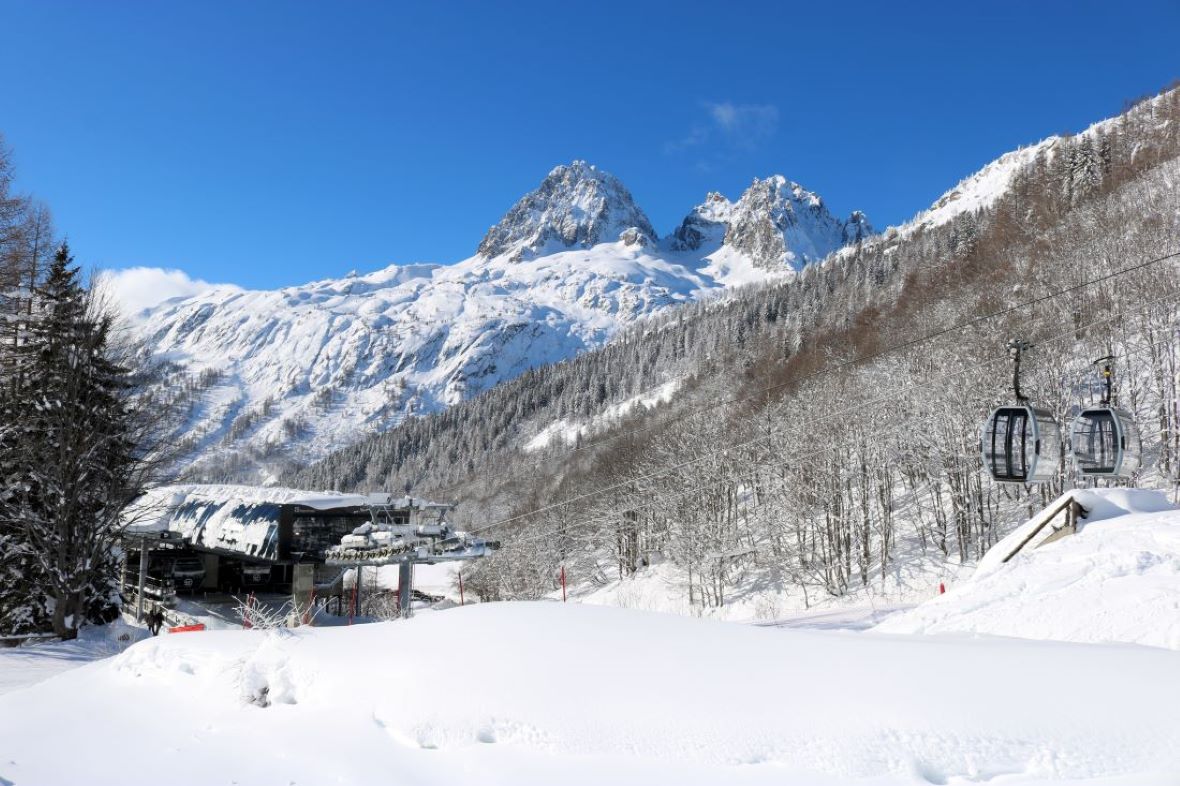
Balme-LeTour-Vallorcine (c) Alexandre_Juillet
Balme is the ski area which stretches between the villages of Le Tour and Vallorcine. It has about 20 pistes, and the top lift reaches 2,195m. Le Tour has an excellent beginners area called Vormaine near its main lift station (Charamillon), whilst Vallorcine has a separate beginners area a train ride away at La Poya near Le Buet. Although there are a few red and black runs, and some interesting terrain for freeriders and ski tourers, Balme mostly consists of easy blue runs which are perfect for novices who have recently graduated from the specialist beginners’ areas, or nervous intermediates. The slopes face in all directions, but those above Le Tour are more south-facing, whilst those above Vallorcine are more north-facing.
Les Houches, including Le Tourchet Beginners’ Area
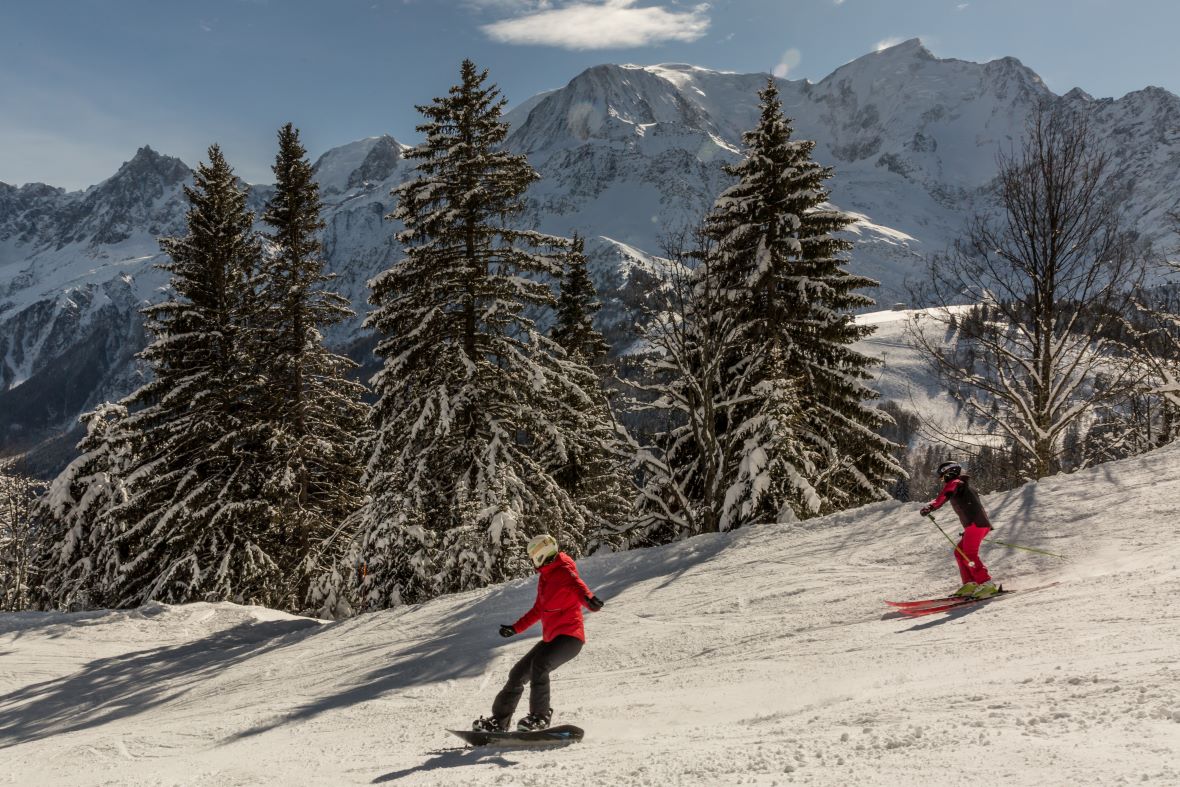
Les Houches (c) Gaetan_Haugear
Les Houches, at the opposite end of the Chamonix valley to Le Tour and Vallorcine, has the lowest ski area (its top lift only reaches 1,900m) but the best tree-skiing, which is a major draw on bad-visibility days. It is has about 25 separate runs including some that stretch nearly all the way down to St Gervais, and a good beginners’ area (Le Tourchet). Le Houches is owned separately so it is not covered by the basic Chamonix ski pass. Most of the skiing is on easy blue and red runs but there are some very good ski touring routes, plus the legendary Kandahar black run used for World Cup races.
Les Planards Beginners’ Area
Les Planards on the southern edge of Chamonix near the Montenvers railway base station is the largest low altitude specialist beginners area with two green runs, one blue run, one red run and a children’s snow garden. It faces north, which helps preserve its snow despite its low altitude (1,062m).
Aiguille du Midi, Mer de Glace gondola, Montenvers cog railway and the Vallee Blanche off-piste descent
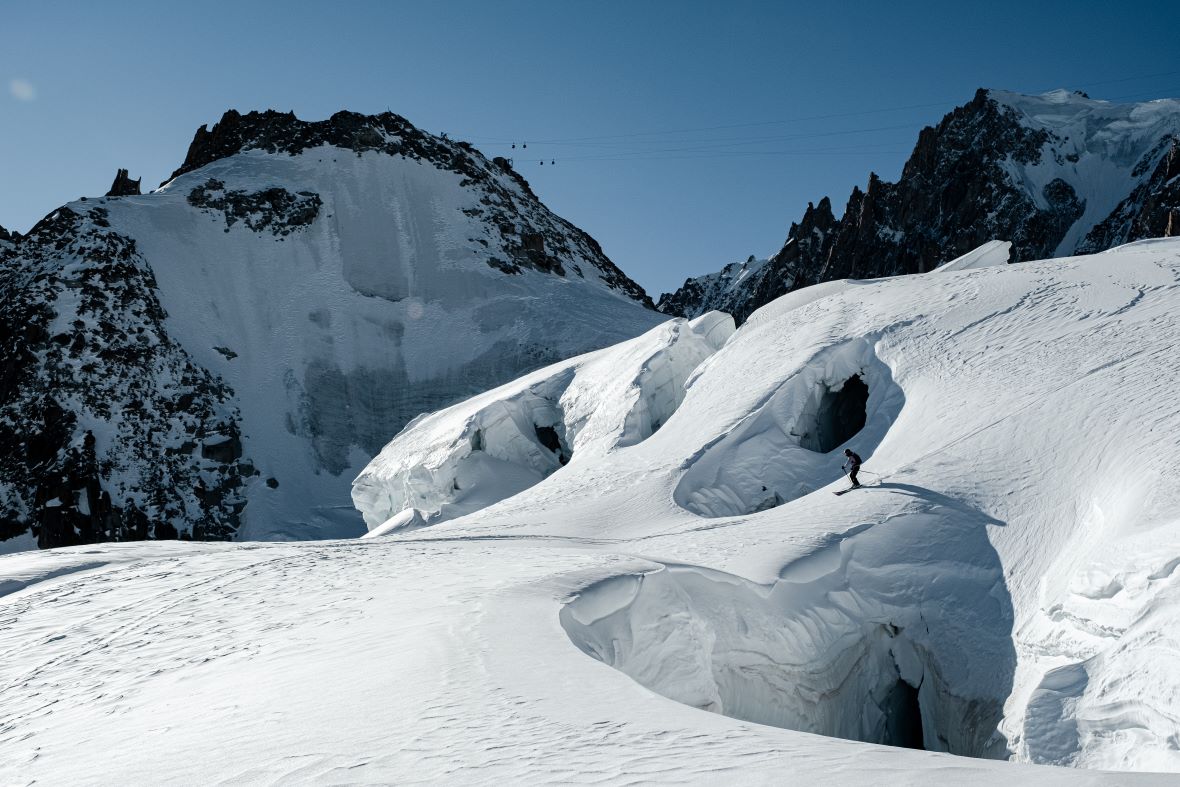
Vallee Blanche (c) Fabian_Bodet.
The Vallee Blanche, Chamonix’s most famous run, is an off-piste descent for which you will need a mountain guide. It’s reached via the spectacular Aiguille du Midi cable car which leaves from the centre of Chamonix and ascends to 3,842m. Guides have considerable scope to vary the descent according to the weather, snow conditions, and their group’s abilities but usually the run ends at the Mer de Glace gondola which takes you up to the top station of the Montenvers cog railway from where you can return to Chamonix.
Beginner Skiing in the Chamonix Valley
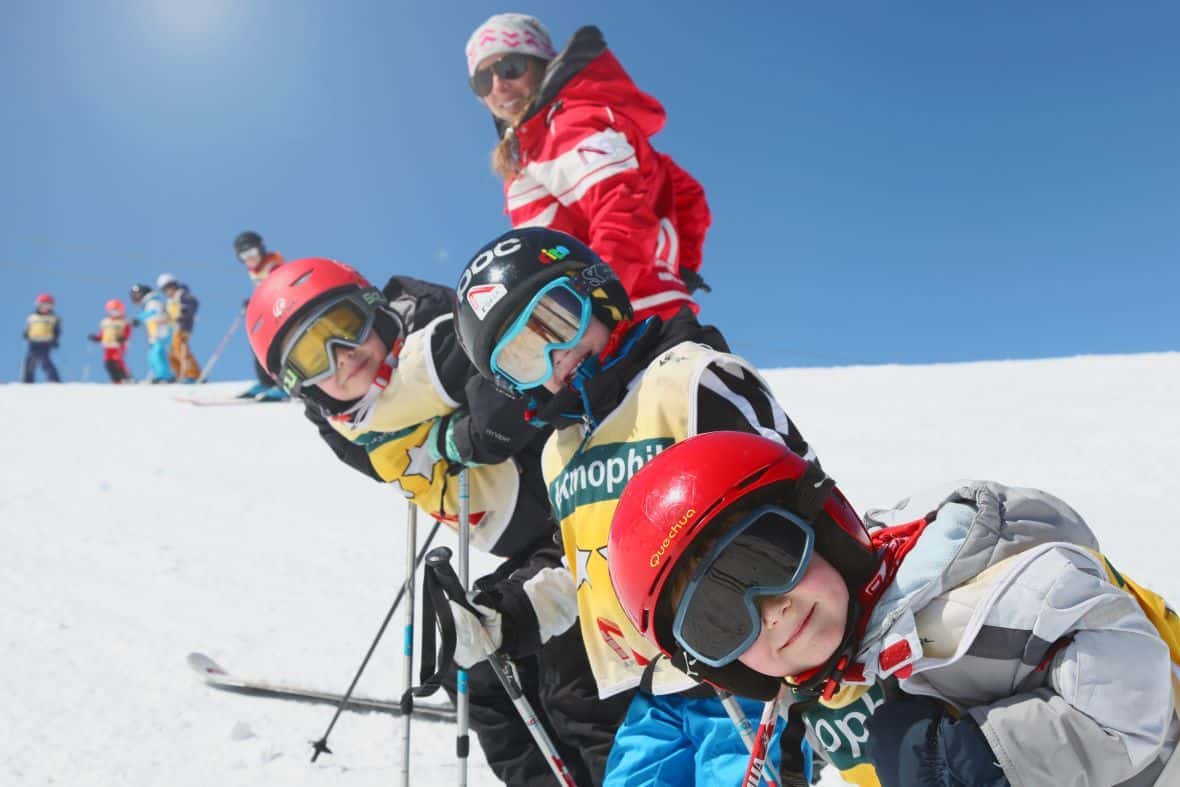
(c) ESF_Argentiere
Chamonix has an exceptionally wide range of beginners’ areas, which means that whatever stage you’re at in learning to ski, and whatever the weather or snow conditions, there is probably one that’s right for you, although it might not be close to where you’re staying. But if you want to stick to one place, Le Tour, which has easy access to the Vormaine nursery slopes and Balme’s novice-friendly blue runs, is probably the best option.
Chamonix has six low-altitude beginners areas: le Tourchet in Les Houches; le Savoy at the bottom of Brevent on the north side of Chamonix; les Planards on the south side of Chamonix; les Chosalets at Argentiere; la Vormaine at Le Tour and la Poya near Le Buet train station close to Vallorcine. There are also two high altitude beginners areas at Plateau 2000 in the Brevent ski area above Chamonix itself, and at Plateau de Lognan in Grands Montets above Argentiere.
The Chamonix Tourist Board offers good value 1st Ski Experience packages for absolute beginners that include tuition and lift passes.
The low altitude areas are the cheapest to use with low cost beginners day and half-day passes, but they can have poor snow. Le Vormaine in Le Tour at 1464m is the highest of the low altitude areas so often has the best conditions, and once beginners are ready to leave the nursery slopes, Le Tour also has the most extensive novice-friendly gentle blue pistes.
Les Planards on the south side of Chamonix is the largest of the low altitude beginners’ ski areas with blue and red runs for beginners to progress onto near to the nursery slopes. Its north-facing orientation also helps preserve its snow.
If snow conditions deteriorate in persistent warm weather, the small but high, north-facing Plateau de Lognan area in Les Grands Montets above Argentiere is a useful back-up option. It’s aimed at ‘Advanced Beginners’. And if it’s actually snowing, and visibility is poor, there are easy blue runs in the trees at Les Houches, and on the Vallorcine side of Balme.
Ski Schools & Ski Lessons in Chamonix, les Houches and Argentiere
Looking for private or group ski lessons in the Chamonix Valley? CheckYeti works with leading ski schools and ski instructors in over 500 ski destinations throughout Austria, France, Germany, Italy and Switzerland. Let them help you choose the right ski school or instructor for you. Qualified and experienced ski instructors and guides at 500+ ski destinations, 6,000+ offers and 24,000+ ski school reviews. View ski schools, classes, offers and discounts, and pre-book your ski lessons online.
Book Ski School Lessons in Chamonix >
Intermediate Skiing in Chamonix
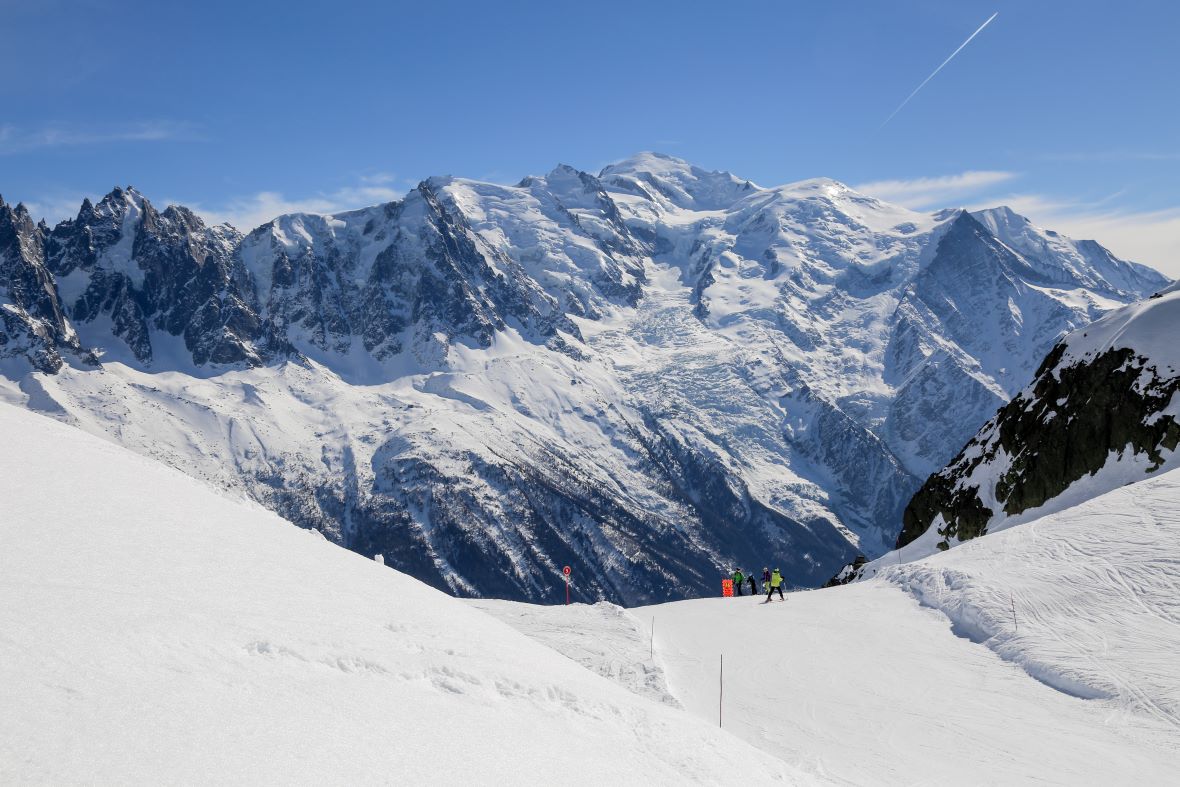
Intermediate skiing in Brevent-Flegere (c) OT_Chamonix-Mont-Blanc SA
Chamonix offers intermediate-level skiers a good range of different slopes and some exhilarating skiing, particularly at Brevent-Flegere, but keen intermediate skiers who want to ski endless lift-linked pistes without getting on a bus or train will find its fragmented separate ski areas frustrating.
Balme-Le Tour Vallorcine has some of the easiest intermediate terrain; the blues are enjoyable and the reds are easier than those in the rest of the ski area. You can also follow the sun, starting on the short runs from the top of Aiguillette de Posettes before moving across to Vallorcine.
Brevent-Flegere has a small blue run area around the Parsa and Sources lifts, but for better intermediates this will merely serve as a warm-up before tacking the wider area which is classic red run territory. The red pistes around the Cornu and Index lifts are particularly good. The Brevent-Flegere sector generally faces south, however, so beware of ice at the start of the day and slush at the end.
The Grands Montets ski area faces north and the snow stays in good condition longer. There is a small blue run area around the Tabe and Retour Pendant lifts for it’s the red runs that are the most memorable. There are only three, so it’s all about quality, not quantity. The two upper red runs (Combes coming down from the Hearse lift, and Bochard from the Bochard lift) can both be combined with the lower red run (La Pierre a Ric) to form wonderful continuous descents, with vertical drops of about 1,250m and 1,500m respectively.
Les Houches has about 20 red and blue runs, most of which are below the treeline. It’s therefore the natural place for intermediates to head to when visibility is bad, but it should also be visited at least once in sunnier conditions, if only to appreciate the glorious views. It’s low elevation (there are no runs above 2,000m) does mean its snow suffers in warm weather, however.
Advanced & Expert Skiing in Chamonix
Skiing on piste
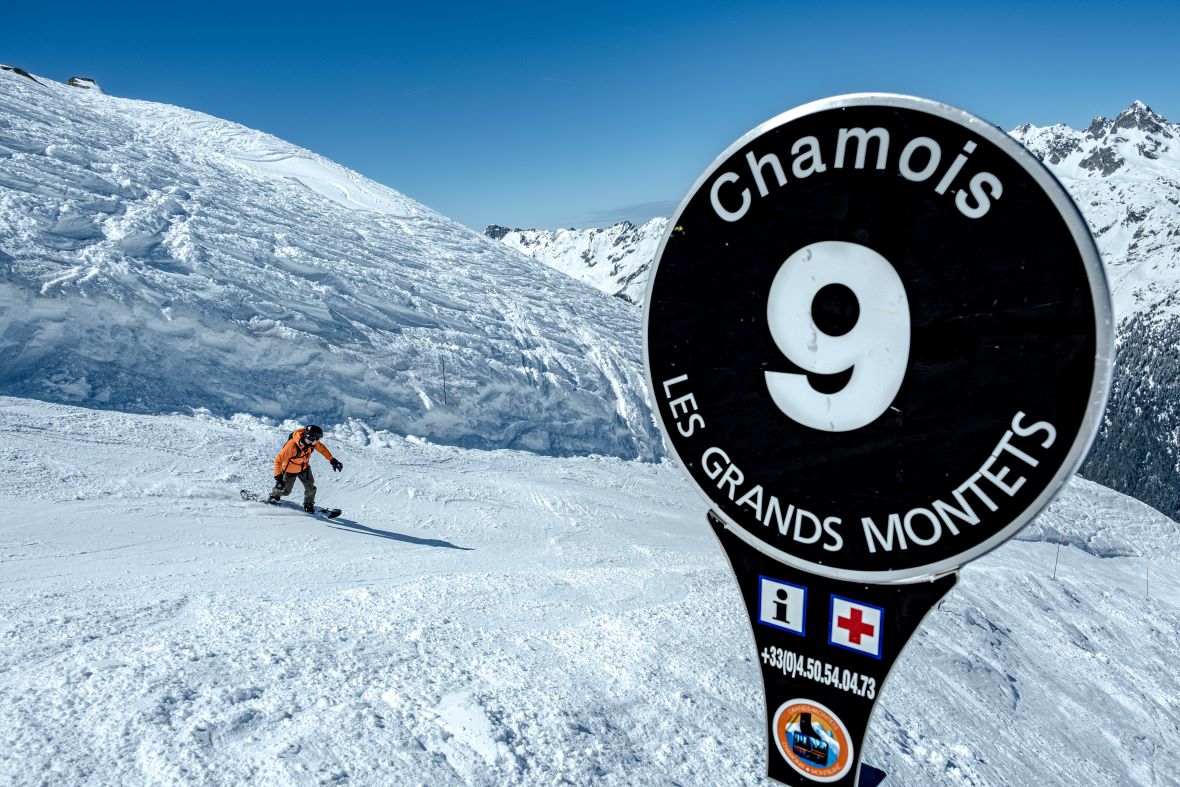
Chamois Black Run in Les Grands Montets (c) Fabian_Bodet
Les Grand Montets has some excellent black runs but whilst the top cable car is out of action, the two highest black runs are closed and out of reach to everyone except ski tourers. This leaves a handful of black runs but they are all north-facing and steep, and usually ungroomed too. If you don’t like ungroomed slopes, try the red runs in the Grands Montets: many would be classified as black runs in other resorts.
The black runs in Brevent-Flegere tend to be south-facing and groomed, presenting a different sort of challenge. Most of them are at the two opposite ends of the ski area, but perhaps the steepest of all is the Bouquetins black run near the middle, which is usually left ungroomed. The two black runs back to the respective base stations in Chamonix and Les Praz are both worth skiing if they are open, but they require good snow cover. Advanced skiers should also try the speed skiing course next to the Chavanne lift: there are no turns, just a straight schuss at maximum speed.
The Les Houches ski area is mostly composed of relatively mild blue and red pistes but it does have the Kandahar black run (previously called Verte), used in FIS World Cup ski meetings. This is surrounded by fir trees, which means the sun rarely gets to it, making it fast and icy. It’s almost 3.5km in length, has an 870m vertical and a series of jumps including the well-known Cassure and the Goulet, although neither is very frightening unless you are skiing at over 80kph like a pro. The best racers can go from top to bottom in less than two minutes.
Off-piste skiing
Skiing off-piste is a way of life in Chamonix with backcountry terrain to suit everyone from ‘powder puppy’ to ‘extreme skier’ but a mountain guide is required to ski it safely.
The Vallee Blanche
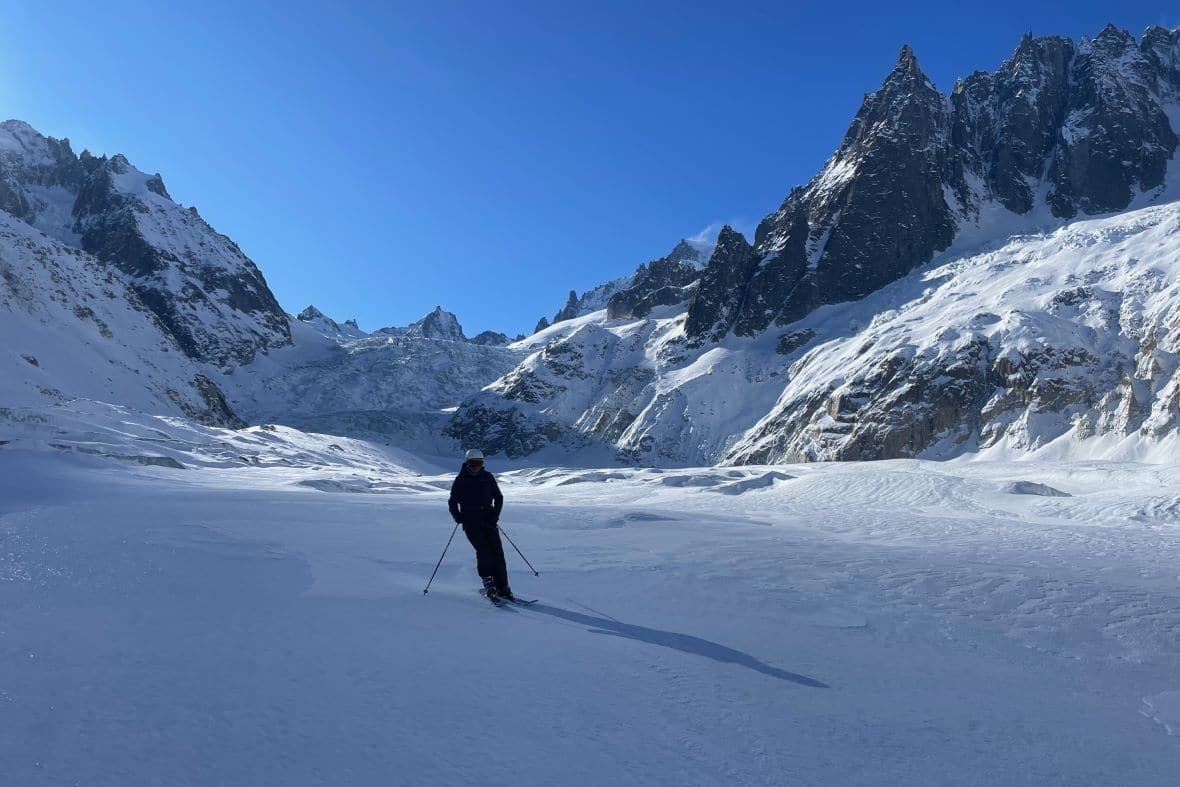
Skiing the Valllee Blanche guided by Loïc Thivierge of the Compagnie des Guides de Chamonix (c) Loïc Thivierge
The Vallee Blanche requires a mountain guide. It’s normally reached via the spectacular Aiguille du Midi cable car which leaves from the centre of Chamonix and ascends to 3,842m above sea level, although there is an alternative starting point from the top of the Skyway lift in Courmayeur, which Chamonix guides can use as a back-up if high winds or snow conditions make them change their plans
From either the Aiguille du Midi or the Skyway, the descent starts by climbing down icy steps for which you may need crampons (check with your guide). After that, guides have plenty of options to choose from and so can alter their route according to the weather, snow, the group’s abilities and interests, and the path chosen by other groups. This means that even if there are hundreds of other skiers booked in to do the Vallee Blanche on the same day as you, you might still be able to lose the crowds and make fresh tracks on virgin snow, or do something completely different, such as ski inside a glaciated canyon bordered by towering walls of ice.
If you ski the easiest route in optimum conditions, even intermediate skiers who have never skied off-piste before can complete the Vallee Blanche. But be honest with your guide about your abilities before setting out and trust their decisions. And if you haven’t skied off-piste before, try to get some practice in, by skiing some ungroomed slopes on Grands Montets.
Usually the Vallee Blanche ends at the Mer de Glace gondola which takes you up to the top station of the Montenvers cog railway from where you can return to Chamonix, but when the snow cover is at its maximum extent, you can sometimes ski all the way back to Chamonix, often via a hike up to the Rochers des Mottets refuge,
Grand Montets
Grands Montets, one of the world’s top off-piste ski mountains, has plenty of off-piste terrain within easy reach of the pistes. There are two bowls on either side of the Hearse lift. The Italian bowl (to skiers’ right) is the steepest and most scenic. From the Bochard lift, you have the option of returning to the lift’s base station by skiing on the broad flanks of the mountain around the Bochard and Combes pistes, or you can ski into the Combe de la Pendant, a massive bowl on either side of the Chamois black run. The possibilities here are endless, but so too are the dangers: in particular look out for cliffs near the top, and unless you are with a guide, never go below the bottom station of the Retour Pendant lift.
When the Grands Montets cable car is in operation, there are off-piste routes on the front face and off the back, heading towards the Glacier des Rognons. Whilst the cable car is closed, this is the preserve of ski tourers who skin-up from the top of the Hearse lift to reach these high altitude descents. There are also good official ski touring climbs from Argentiere to the Lognan mid-station.
The Grands Montetes ski area is also the jumping off point for much more extensive off-piste and ski touring itineraries which take you far away from the lifts and pistes, and for which a mountain guide is definitely needed. The most famous of these is the Haute Route which stretches all the way to Zermatt in Switzerland but which normally starts with crossing the Glacier d’Argentiere.
Brevent-Flegere
Brevent-Flegere probably has even more off-piste terrain than Grands Montets, and some of it, especially around the Brevent Col, can be just as challenging. But Brevent-Flegere faces south and warms up quickly on sunny days, so timing is everything.
Balme-Le Tour-Vallorcine
The Le Tour side of Balme has some great gentle terrain for learning to ski off-piste, and there are also some slightly steeper slopes that lead into the woods above Vallorcine. There is also excellent ski touring up and down the summit of Balme.
Les Houches
Skiing between the trees in Les Houches is a great alternative to the high open bowls in the rest of Chamonix valley when the weather turns bad. But the best routes are not easy to find, so a guide is strongly recommended. There are also official ski touring circuits for which a guide is not needed.
Boarding & Freestyle in Chamonix
All the Chamonix sectors have something to offer boarders and freestyle skiers, either in man-made snowparks and boardercross courses or via natural gullies and half-pipes.
The snowpark at Grand Montets is near the Marmattons and Bochard lifts. There are technical routes for experts (it meets FIS competition standards) but also less testing descents for beginners and intermediates. The showcase Enthusiasts route is 800m long. There are also plenty of gullies in the natural terrain.
In Blame-Le Tour-Vallorcine there is the Summit snowpark near the le Col lift. It is one of the largest snowparks in Europe and meets FIS standards. There are aso plenty of half-pipes near the pistes.
In Brevent-Le Tour there is a small boardercross area near the Cornu pitse, and a large air bag and a set of rails near the Parsa lift.
In Les Houches the Bellevue Snowpark near the top of the Crozat lift has routes for beginners and experts.
Mountain Restaurants in the Chamonix Valley
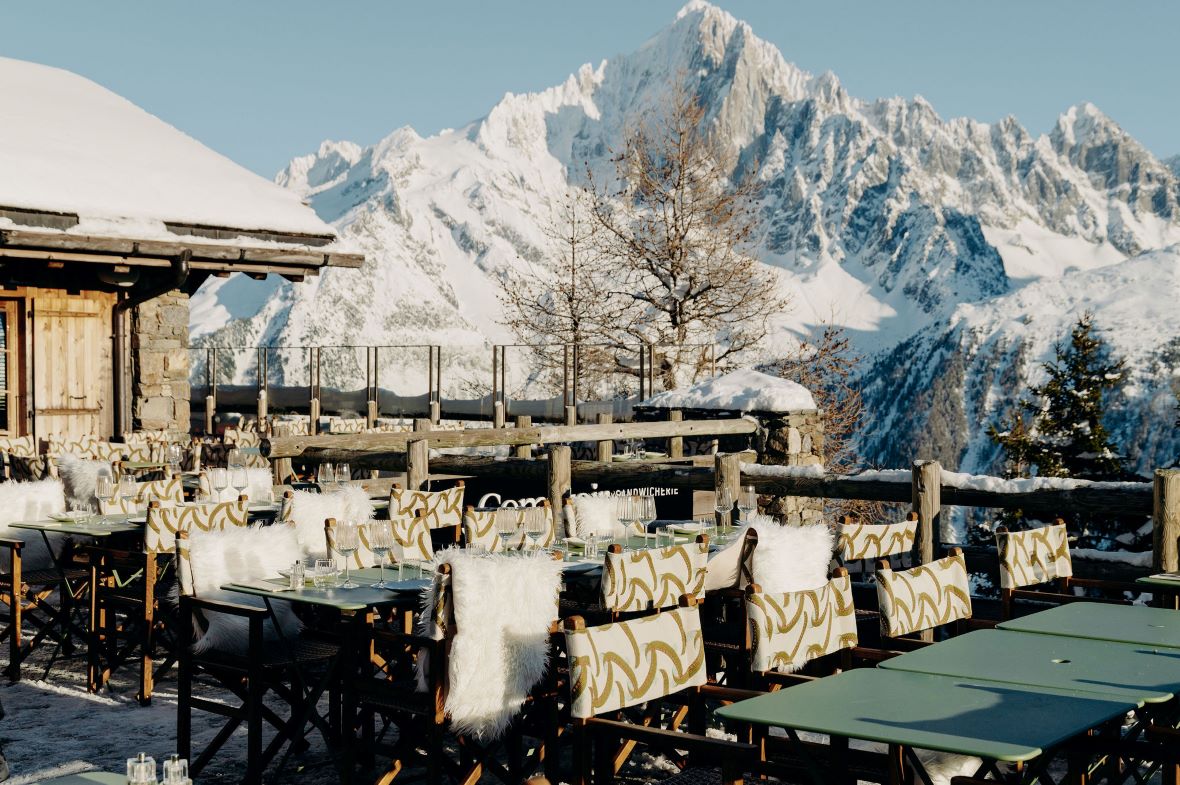
La Bergerie at Planpraz (c) Labon3
Chamonix has fewer mountain restaurants than other famous ski resorts, but they tend to be in spectacular locations with amazing views and often cater for non-skiers as well as skiers, so book ahead in peak periods.
Nowhere exemplifies this more than Le 3842 at the summit of the Aiguille du Midi. It has good food but it’s the scenery that is most memorable. La Refuge de Montenvers at the other end of the Vallee Blanche also has views that draw in visitors in summer as well as winter.
Across the valley, in Brevent, Le Panoramic and Le Cabane are both quite upmarket mountain restaurants, whilst Le Bergerie is more mid-range, but all have great views. At the other end of the domain in Flegere, L’Adret and Foehn both belong to the respected Maison des Drus chain.
In Argentiere, the Refuge de Lognan on the very edge of the ski area, is an old favourite of off-piste skiers and ski tourers for its views over the glacier. To make a reservation, call +33 6 88 56 03 54.
For full, up-to-date listings of mountain restaurants, see the Chamonix-Mont Blanc Tourist Board Website Mountain Restaurants Section.










